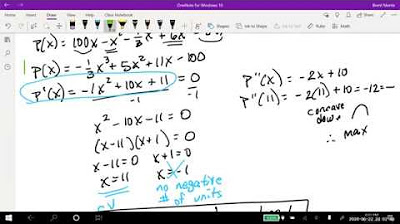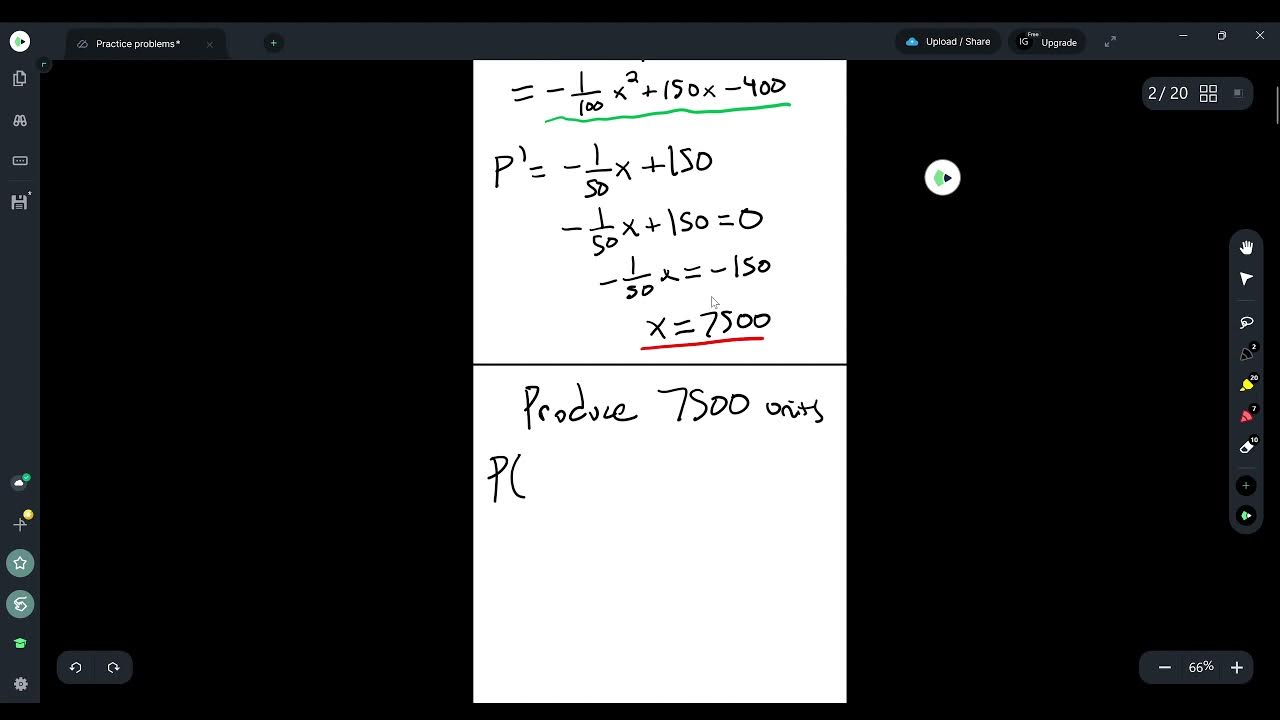Maximization Word Problem #1!
TLDRThe video script presents a review problem from a mathematics section focusing on word problems related to maximizing yield in an orchard. The problem involves an orchard with 30 trees per acre, each yielding 480 peaches. The challenge is to determine how many additional trees should be planted per acre to maximize the total yield, given that each added tree reduces the yield of all trees by 12 peaches per tree. The presenter guides viewers through the process of creating a yield function, taking into account the base case of 30 trees and the adjustment for each additional tree. The function is then simplified and a derivative is taken to find the critical point, which is used to determine the maximum yield. The second derivative test confirms the presence of a maximum, leading to the conclusion that adding five trees per acre will maximize the yield. The summary provides a clear and concise explanation of the problem-solving process, making it accessible to viewers.
Takeaways
- 📚 Start by reading and summarizing the problem: The current orchard has 30 trees per acre, each yielding 480 peaches. An additional tree planted per acre reduces the yield by 12 peaches per tree.
- 🎯 Identify the goal: Determine how many additional trees per acre should be planted to maximize the yield.
- 🌱 Establish a yield function: The function should represent the total number of peaches produced based on the number of trees and the yield per tree.
- 🔢 Use a variable to represent the increase: Let 'I' be the number of additional trees per acre.
- 🍑 Base case scenario: Initially, there are 30 trees per acre yielding 480 peaches each.
- 🔄 Adjustment for additional trees: For each additional tree, the yield per tree decreases by 12 peaches.
- 📊 Formulate the yield function: The function is the product of the number of trees (30 + I) and the adjusted yield per tree (480 - 12I).
- 🔍 Simplify the function: The simplified yield function is 14400 + 480I - 360I - 12I^2.
- 📈 Maximize the yield: Use calculus to find the maximum point of the yield function, which corresponds to the optimal number of additional trees.
- 🧮 Calculate the derivative: The first derivative of the yield function is 480 - 360I - 24I^2.
- ✍️ Solve for critical points: Set the first derivative equal to zero and solve for 'I' to find the critical points.
- 🔑 Confirm the maximum: Use the second derivative test to confirm that the critical point corresponds to a maximum.
- 🏁 Final answer: Add five trees per acre to maximize the yield.
Q & A
What is the current number of trees per acre in the orchard?
-The current number of trees per acre in the orchard is 30.
How many peaches does each tree yield in the orchard?
-Each tree in the orchard yields 480 peaches.
What happens to the yield per tree when an additional tree is planted per acre?
-For each additional tree planted per acre, the yield per tree is reduced by 12 peaches.
What is the goal of the problem?
-The goal of the problem is to determine how many trees should be added per acre to maximize the yield of peaches.
What is the variable 'I' representing in the problem?
-The variable 'I' represents the number of increases, or the amount of trees added per acre.
What is the initial yield function that was developed to represent the situation?
-The initial yield function is the product of the number of trees and the number of peaches per tree, which is (30 + I) * (480 - 12I).
What is the simplified form of the yield function?
-The simplified form of the yield function is 14400 + 480I - 360I - 12I^2.
What mathematical process is used to find the maximum yield?
-The mathematical process used to find the maximum yield is calculus, specifically finding the critical points by taking the derivative of the yield function and setting it to zero.
What is the result of the derivative of the yield function?
-The derivative of the yield function is 120 - 24I.
How many trees should be added per acre to maximize the yield according to the solution?
-According to the solution, 5 trees should be added per acre to maximize the yield.
What test was used to confirm that the critical point found is a maximum?
-The second derivative test was used to confirm that the critical point found is a maximum. The second derivative was negative, indicating a concave down shape and thus a maximum.
What is the final answer to the problem?
-The final answer to the problem is to add five trees per acre to maximize the yield of peaches.
Outlines
🍑 Maximizing Peach Yield in an Orchard
The first paragraph introduces a review problem from section 3.3, focusing on a word problem involving an orchard's peach yield. The current situation is described, with 30 trees per acre yielding 480 peaches each. The problem statement is to determine how many additional trees should be planted per acre to maximize the total yield, given that each additional tree reduces the yield of all trees by 12 peaches. The presenter outlines the steps to solve the problem: understanding the problem, identifying the goal (maximizing yield), and formulating a yield function that includes the number of trees and the number of peaches per tree, adjusting for the reduction in yield as more trees are added. The function is simplified to prepare for finding the maximum yield.
📈 Calculating the Optimal Number of Trees for Maximum Yield
The second paragraph delves into the process of finding the maximum yield by differentiating the yield function and solving for critical points. The presenter simplifies the yield function and then differentiates it to find the first derivative. By setting the first derivative equal to zero and solving for the variable representing the number of additional trees (I), the presenter finds that five trees should be added per acre to achieve the maximum yield. A second derivative test confirms that this is indeed a maximum, not a minimum. The presenter concludes with the final answer, advising to add five trees per acre to maximize the peach yield.
Mindmap
Keywords
💡Orchard
💡Yield
💡Trees per acre
💡Peaches per tree
💡Word problem
💡Section 3.3
💡Critical point
💡Derivative
💡Second derivative test
💡Maximize
💡Function
Highlights
The problem is from section 3.3, a confusing section with word problems.
The problem is number 17, found on page 272.
The orchard currently has 30 trees per acre, each yielding 480 peaches.
For each additional tree planted per acre, the yield per tree is reduced by 12 peaches.
The goal is to determine how many trees should be added per acre to maximize yield.
The first step is to read and summarize the problem.
The second step is to identify what is being asked, which is the number of trees to add per acre.
The third step is to figure out the function that will help maximize or minimize the yield.
A yield function is created, starting broad and then filling in the variables.
The base case is 30 trees per acre, each producing 480 peaches.
The adjustment is adding I trees per acre, reducing the yield per tree by 12I.
The yield function is simplified to 14400 + 480I - 360I - 12I^2.
The goal is to find the maximum of this function using calculus.
The derivative of the yield function is found to be 120 - 24I.
Setting the derivative equal to zero gives I = 5 as the critical point.
The second derivative test confirms that I = 5 is a maximum.
The final answer is to add 5 trees per acre to maximize yield.
Transcripts
5.0 / 5 (0 votes)
Thanks for rating:





